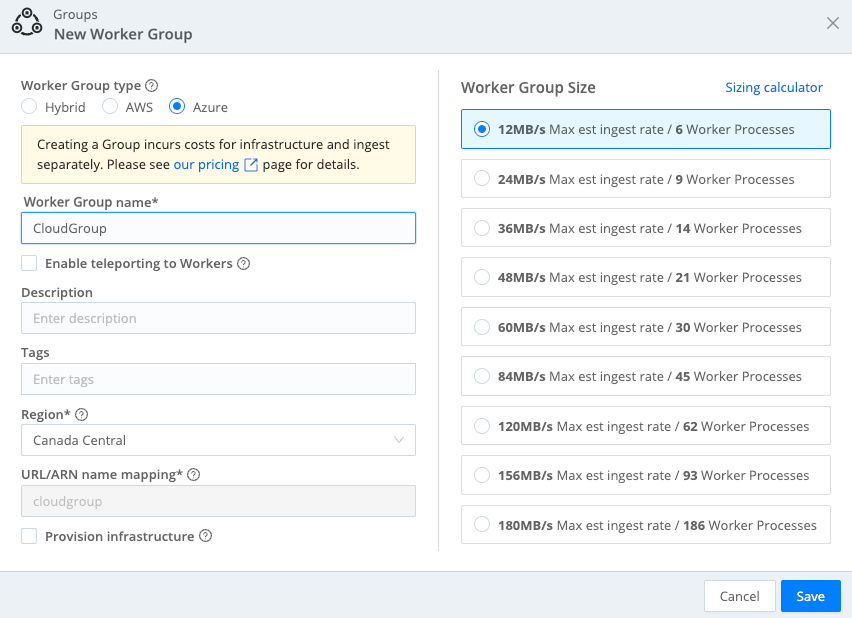These docs are for Cribl Stream 4.12 and are no longer actively maintained.
See the latest version (4.15).
Manage Cribl.Cloud Worker Groups
Using Cribl.Cloud’s in-app controls, you provision Cribl-managed Worker Nodes in Cribl.Cloud to match the throughput capacity you need. With certain plan/license tiers, you have the option to add and configure multiple Cribl-managed and/or customer-managed (hybrid) Groups.
Cloud Worker Group Providers
Cribl-managed Worker Groups in Cribl.Cloud can be based in one of two providers: AWS or Azure.
Select the provider based on, for example, where your primary Sources and Destinations are located. This will help you reduce transit costs and reduce latency.
The supported regions are:
| AWS Region name | AWS Region | Azure Region Name | Azure Region |
|---|---|---|---|
| Australia East | ap-southeast-2 | Australia East | australiaeast |
| Canada Central | ca-central-1 | Canada Central | canadacentral |
| Germany West Central | eu-central-1 | Germany West Central | germanywestcentral |
| UK South | eu-west-2 | UK South | uksouth |
| US East (N. Virginia) | us-east-1 | East US | eastus |
| US East (Ohio) | us-east-2 | East US 2 | eastus2 |
| US West (Oregon) | us-west-2 | West US 2 | westus2 |
Create a Cloud Worker Group
All Cribl.Cloud Organizations start out with one Worker Group. To create additional Cloud Worker Groups (with certain plan/license tiers):
On the top bar, select Products, and then select Stream.
Select Add Group.
In the New Group modal, in Worker Group Type, select your preferred provider:
AWSorAzure.You can create up to 10 Cloud Worker Groups per Workspace. If you need to increase this limit, contact Cribl Support.
Select the Azure or AWS Region where you want to locate the Worker Group.
Enter a Group name.
Select Enable teleporting to Workers if you want to enable authenticated access to the Worker Node’s UI from the Leader.
Select Provision infrastructure if you want Cribl.Cloud to automatically create Worker Nodes.
The URL/ARN name mapping is an auto-generated, unique identifier for your Cloud Worker Groups. It follows stricter naming rules than the Group name.
Optionally, enter a Description.
You can also add Tags to help organize Worker Groups into logical categories. Then, you can search by tags on the View all Groups interface.
Use the Sizing calculator to determine the recommended Worker Group Size. For details, see Using the Sizing Calculator.
Select the Worker Group Size based on the recommendation. This setting controls the number of Worker Nodes that will be provisioned, assuming a 1:2 ingest:egress ratio.
Confirm with Save.
For general guidance about capacity required for your deployment, see our Planning and Sizing topics.

Azure Cloud Workers and Resources in the Same Region
If you are using an Azure-based Cribl-managed Worker Group located in the same Azure region as another resource (for example, an Azure-based Source or Destination), the two resources may not be able to communicate. This may happen if network rules on the Azure resource are enabled by setting Public network access to Enabled from selected virtual networks and IP addresses on Azure portal’s Storage Account > Security + networking page.
This is due to how intra-region cloud routing occurs in Azure over the CSP backbone network leveraging resource private IPs.
You can resolve this by moving the Worker Group to another Azure region. However, this will incur additional egress fees.
Use the Sizing Calculator
The Sizing calculator is an in-built feature within Cribl Stream Cloud that aids users in determining the appropriate size for their Worker Groups, either during creation or resizing processes. This tool helps you make informed decisions based on your specific data volume and processing needs.
When creating a new Worker Group, the Sizing calculator section is within the Worker Group configuration modal. When resizing an existing Worker Group, navigate to the Group Settings > Group Configuration section for the desired Worker Group.
To generate the recommended sizing:
- Use the slider to enter the anticipated Daily inbound data volume in
TB. - Use the slider to enter the anticipated Daily outbound data volume in
TB. - Select your Processing load based on data transformation complexity. Low for simple tasks like Masking or Renaming, Medium for functions like Rollups or Aggregations, and reserve High for resource-intensive operations like Regex extraction or custom code.
- Select Recommend Sizing. The tool will highlight a recommended Worker Group Size tier. You can choose a different tier from the available options if your needs differ slightly from the recommendation.
Provision and Manage Infrastructure
If you select Provision Infrastructure, the infrastructure will be provisioned about 30 minutes later. You will receive an in-portal notification confirming the change.
You can change Worker Group configuration later, including modifying the Worker Group Size, which may change the number of provisioned Worker Nodes.
Control Costs
Cribl will draw down your Cribl.Cloud credits to cover the base cost of maintaining the infrastructure, as well as your normal cost for ingested data.
You can minimize the costs by clearing Provision infrastructure.
You can do so either when creating the Worker Group, or at any later time when you are ingesting no data.
With this setting, the Worker Group will go dormant, and your base infrastructure cost for this Worker Group will be 0.
In this state, the Worker Group will contain no Worker Nodes and will ingest no data.
When you deprovision a Worker Group, Stream retains the configuration so you can reprovision it if needed. However, any persistent queue data on the Worker Nodes will be permanently deleted.





